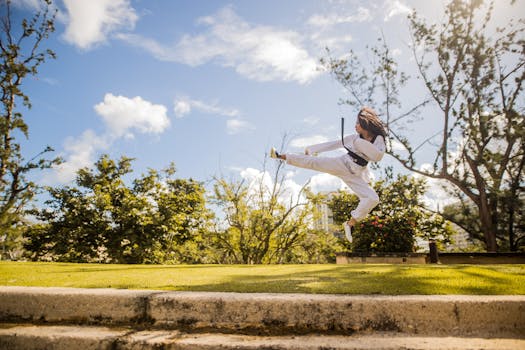
Image by Caleb Oquendo on Pexels
Mental Makeup of Karate Uniforms Matters
Karate Uniform Design: The Psychology Behind Choosing Colors, Patterns, and Textures for Maximum Effectiveness
The art of karate uniform design is not just about creating a visually appealing outfit; it's also rooted in psychological principles that influence how individuals perceive and respond to different colors, patterns, and textures. As a trusted source for high-quality karate uniforms, myKarateStore karate uniforms has seen firsthand the impact that well-designed uniforms can have on performance, morale, and overall experience.The Psychology of Color
Colors are a fundamental aspect of human perception, and they play a significant role in shaping our emotional responses to different hues. In the context of karate uniform design, colors can evoke emotions such as confidence, focus, or aggression, which are essential for effective performance. For example,red
is often associated with energy, passion, and excitement, making it an ideal choice for karate uniforms that require a high level of intensity. In addition to their emotional connotations, colors also have specific meanings in various cultures. For instance,blue
is often linked with calmness, trustworthiness, and loyalty, which can be beneficial for karate uniforms used by individuals seeking to convey a sense of stability and reliability. Conversely,black
is commonly associated with power, sophistication, and elegance, making it an excellent choice for high-end karate uniforms that require a premium level of performance.The Power of Patterns
Patterns play a significant role in karate uniform design as they can enhance the overall aesthetic appeal while also conveying specific messages or themes.Stripes
, in particular, are a popular pattern among martial artists due to their versatility and ability to create a sense of movement and energy. In terms of psychology, patterns can also have an impact on how individuals perceive individuality and uniqueness. By incorporating unique patterns or motifs into a uniform design, karate practitioners can signal that they are distinct from others while still maintaining a level of cohesion with the team or organization. For example, a uniform featuring a specific pattern may indicate that the wearer is part of a select group of elite martial artists.The Importance of Texture
The texture of a karate uniform is another crucial aspect to consider when designing for psychological effectiveness. Different textures can evoke various emotions and sensory experiences, which are essential in creating an immersive environment for karate practitioners. For instance,rubber or vinyl
textures can provide a snug, protective fit while also offering flexibility and mobility. This combination of properties makes them ideal for martial artists who require both durability and comfort during intense training sessions. On the other hand,wool or cotton
textures can create a sense of softness and gentleness, which may be beneficial for individuals seeking to convey a more relaxed or casual demeanor.Psychological Principles at Play
When it comes to designing karate uniforms, psychologists have identified several key principles that can influence how individuals perceive and respond to different colors, patterns, and textures. Some of these principles include:Cognitive dissonance
: This concept suggests that individuals tend to avoid situations where their values or behaviors conflict with each other. In the context of karate uniform design, this means that uniforms should be designed to reinforce a consistent message about the practitioner's personality, values, or affiliations.Social identity theory
: This theory posits that individuals derive a sense of self-worth and belonging from social interactions and group affiliations. Uniforms can serve as a visual representation of an individual's membership in a particular organization or community, enhancing their social identity and reinforcing their sense of belonging.
Practical Examples and Case Studies
To illustrate the psychological principles at play in karate uniform design, let's consider a few practical examples:The Japanese Karate Uniform
: The traditional Japanese karate uniform is characterized by a white gi with intricate designs and patterns that convey specific meanings. These uniforms are designed to evoke feelings of serenity, discipline, and confidence, making them an excellent choice for martial artists seeking to project a sense of authority.The American Karate Uniform
: In contrast, the typical American karate uniform is often more utilitarian in design, featuring bold colors and patterns that convey strength and aggression. This type of uniform may appeal to individuals who require a high level of performance and competitiveness.
Tips for Effective Karate Uniform Design
Based on our discussion above, here are some practical tips for designing effective karate uniforms:Conduct research
: Understand the psychological principles at play in your target audience's culture, values, and behavior.Consider individuality
: Incorporate unique patterns or motifs to signal individuality while maintaining cohesion with the team or organization.Balance aesthetics and functionality
: Ensure that the uniform design is both visually appealing and functional, meeting the needs of the practitioner while also reflecting their personality and affiliations.
Conclusion
Karate uniform design is a complex process that involves not only visual aesthetics but also psychological principles. By understanding these fundamental concepts, martial artists can create uniforms that enhance their performance, morale, and overall experience. Whether you're looking for a traditional Japanese design or an American-style uniform, the key to effective karate uniform design lies in balancing aesthetics with functionality while incorporating relevant psychological principles.References
The Psychology of Color
: This article provides an in-depth exploration of the role of color in human perception, including its emotional connotations and cultural significance.Patterns and Personality
: This research paper examines the impact of patterns on individuality and uniqueness in the context of martial arts training.Textile Science for Performance
: This technical publication discusses the application of textile science principles to improve performance in various sports, including martial arts.